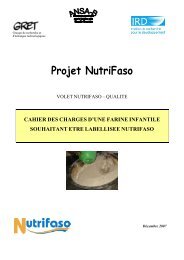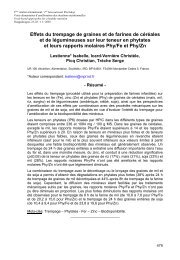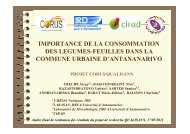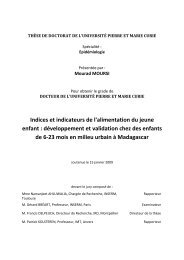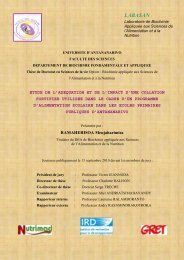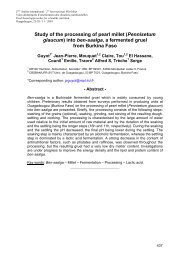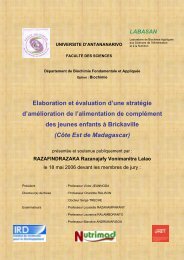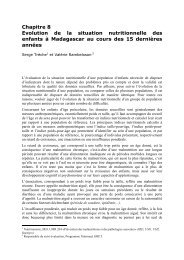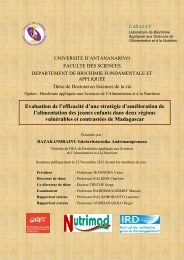942 E.H. Tou et al. / Food Chemistry 100 (2007) 935–943 some conclusions to be drawn about the metabolic activity of LABs involved in the different process combinations. Two stages were distinguished in the control and inoculated experiments (CI and CMI) but not in CM. The first stage corresponded roughly to the first half of the total fermentation time, when there was a simultaneous increase in both ethanol and lactic acid concentrations, and the second stage when there was no longer an increase in the concentration of ethanol, while the increase in lactic acid continued. The first stage indicates that both homo and heterofermentative LABs and possibly yeasts could be active, and the second stage that mainly homofermentative LAB could still be active in conditions, where the pH is very low. This variation in metabolic pattern is consistent with general descriptions given for many plant-based fermented foods in relation to temporal variations displayed by the different LAB species during the course of fermentation (Ampe, ben Omar, Moizan, Wacher, & Guyot, 1999; Brauman, Kéléké, Malonga, Miambi, & Ampe, 1996). In the CI process combination, the implementation of the processes of pre-cooking and inoculation by back-slopping had a small positive effect on the gruel ED which reached 62 kcal/100 g for a sweetened gruel at a Bostwick flow of 120 mm/30 s, against 39 kcal/100 g for a sweetened control gruel. This could be explained by the fact that gelatinization during pre-cooking makes the starch more susceptible to a slight amylolysis by amylolytic lactic acid bacteria (ALAB). The counts of lactic acid microflora in fermented slurries indeed showed the presence of ALABs with an ALAB/LAB ratio of 0.06 (Table 1). Similar studies reported the presence of ALABs in many cereal-based fermented foods (Diaz-Ruiz, Guyot, Ruiz-Teran, Morlon- Guyot, & Wacher, 2003; Johansson, Sanni, Lonner, & Molin, 1995; Sanni, Morlon-Guyot, & Guyot, 2002) and the ability of their a-amylase to hydrolyze raw starch (Rodriguez-Sanoja et al., 2000). However, it is shown here that even if the gelatinized starch did favour amylolysis by ALAB amylases, natural fermentation was not efficient enough to reduce the viscosity of the gruel enough to obtain gruels with appropriate ED values. The gruel obtained using the CMI process combination had an ED of about 82 kcal/100 g after sugar had been added. This ED is significantly higher (P
E.H. Tou et al. / Food Chemistry 100 (2007) 935–943 943 Calderon, M., Loiseau, G., & Guyot, J. P. (2001). Nutritional requirements and simplified cultivation medium to study growth and energetics of a sourdough lactic acid bacterium Lactobacillus fermentum Ogi E1 during heterolactic fermentation of starch. Journal of Applied Microbiology, 90, 508–516. Den Besten, L., Glatthaar, I. I., & Ijsselmuiden, C. B. (1998). Adding a- amylase to weaning food to increase dietary intake in children. A randomized controlled trial. Journal of Tropical Pediatrics, 44, 4–9. Dewey, K. G., & Brown, K. H. (2003). Update on technical issues concerning complementary feeding of young children in developing countries and implications for intervention programs. Food Nutrition Bulletin, 24(1), 5–28. Diaz-Ruiz, G., Guyot, J. P., Ruiz-Teran, F., Morlon-Guyot, J., & Wacher, C. (2003). Microbial and physiological characterization of weak amylolytic but fast growing lactic acid bacteria: a functional role in supporting microbial diversity in pozol, a Mexican maize sourdough. Applied and Environmental Microbiology, 69, 4367–4374. Duncan, D. B. (1955). Multiple range and multiple-F tests. Biometrics, 11, 1. Guyot, J.P., Mouquet, C., Tou, E.H., Counil, E., Traore, A.S., Trèche, S., (2003). Study of the processing of pearl millet (Pennisetum glaucum) into ben-saalga, a fermented gruel from Burkina Faso. <strong>El</strong>ectronic proceedings of the 2nd international workshop food-based approaches for a healthy nutrition in West Africa: the role of food technologists and nutritionists, 25–28 November 2003, Ouagadougou (www.univ-ouaga.bf/fn2ouaga2003). Johansson, M. L., Sanni, A., Lonner, C., & Molin, G. (1995). Phenotypically based taxonomy using API 50 CH of lactobacilli from Nigerian ogi, and the occurrence of starch fermenting strains. International Journal of Food Microbiology, 25, 159–168. Kitabatake, N., Gimbi, D. M., & Oi, Y. (2003). Traditional non-alcoholic beverage, togwa, in East Africa, produced from maize flour and germinated finger millet. International Journal of Food Sciences and Nutrition, 54(6), 447–455. Lorri, W., & Svanberg, U. (1993). Lactic acid-fermented cereal gruels: viscosity and flour concentration. International Journal of Food Sciences and Nutrition, 44, 207–213. Lorri, W., & Svanberg, U. (1994). An overview of the use of fermented foods for child feeding in Tanzania. Ecology of Food and Nutrition, 34, 65–81. Mercier, C., & Colas, A. (1967). Les amylases en panification. Annales de Nutrition et Alimentation. France, 21, B299–B340. Mosha, A. C., & Svanberg, U. (1983). Preparation of weaning foods with high nutrient density using flour of germinated cereals. Food Nutrition Bulletin, 5(2), 10–14. Moursi, M., Mbemba, F., & Trèche, S. (2003). Does the consumption of amylase-containing gruels impact on the energy intake and growth of Congolese infants. Public Health Nutrition, 6(3), 249–257. Nout, M. J. R., Rombouts, F. M., & Havelaar, A. (1989). Effect of accelerated natural lactic fermentation of infant food ingredients on some pathogenic microorganisms. International Journal of Food Microbiology, 8, 351–361. Oyewole, O. B. (1997). Lactic fermented foods in Africa and their benefits. Food Control, 8, 289–297. Rodriguez-Sanoja, R., Morlon-Guyot, J., Jore, J., Pintado, J., Juge, J., & Guyot, J. P. (2000). Comparative characterization of complete and truncated forms of Lactobacillus amylovorus a-amylase and the role of the C-terminal direct repeats in raw starch binding. Applied and Environmental Microbiology, 66, 3350–3356. Sanni, A. I., Morlon-Guyot, J., & Guyot, J. P. (2002). New efficient amylase-producing strains of Lactobacillus plantarum and L. fermentum isolated from different Nigerian traditional fermented foods. International Journal of Food Microbiology, 72, 53–62. Thaoge, M. L., Adams, M. R., Sibara, M. M., Watson, T. G., Taylor, J. R. N., & Goyvaerts, E. M. (2003). Production of improved infant porridges from pearl millet using a lactic acid fermentation step and addition of sorghum malt to reduce viscosity of porridges with high protein, energy and solids (30%) content. World Journal of Microbiology and Biotechnology, 19, 305–310. Tou, E.H., Guyot, JP., Mouquet-Rivier, C., Rochette, I., Counil, E., Traoré, A.S., et al. Study through surveys and fermentation kinetics of the traditional processing of pearl millet (Pennisetum glaucum) into ben-saalga, a fermented gruel from Burkina Faso. International Journal of Food Microbiology [in press]. Trèche, S. (1999). Techniques for improving the energy density of gruel. In M.-C. Dop, D. Benbouzid, S. Trèche, B. de Benoist, A. Verster, & F. Delpeuch (Eds.), Complementary feeding of young children in Africa and the middle-East (pp. 101–119). Geneva: World Health Organization (WHO/NHD/99.3 et WHO/AFRO/NUT/99.4). Vieu, M. C., Traoré, T., & Trèche, S. (2001). Effects of energy density and sweetness of gruels on Burkinabe infant energy intakes in free living conditions. International Journal of Food Sciences and Nutrition, 52, 213–218. Westby, A., & Gallat, S. (1991). The effect of fermentation on the viscosity of sorghum porridges. Tropical Science, 31, 131–139.



